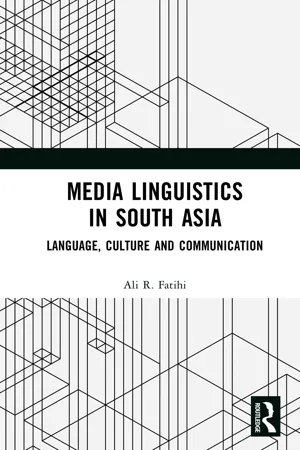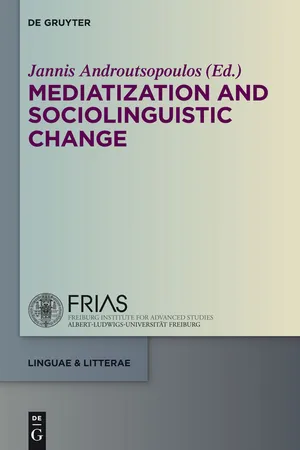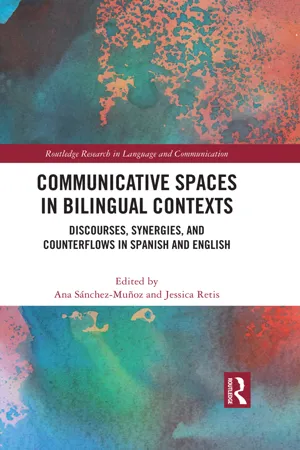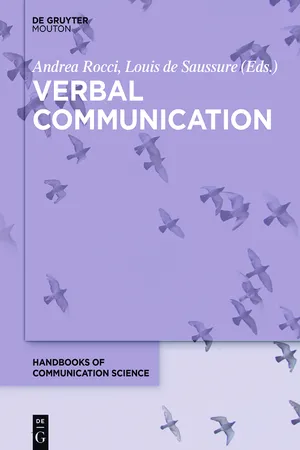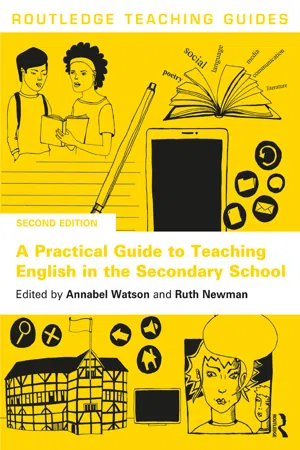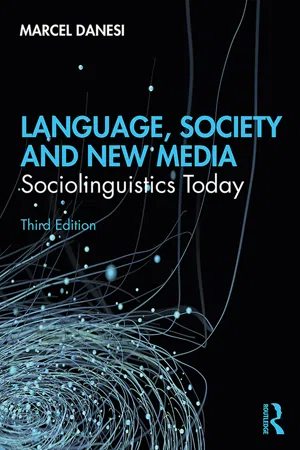Languages & Linguistics
Media Linguistics
Media linguistics is the study of language as it is used in various forms of media, such as television, radio, and the internet. It examines how language is used to convey meaning, shape public opinion, and influence behavior in the media environment. This field explores the relationship between language and media, including the impact of media on language use and vice versa.
Written by Perlego with AI-assistance
Related key terms
Related key terms
1 of 4
Related key terms
1 of 3
7 Key excerpts on "Media Linguistics"
- eBook - ePub
- Kristina Bedijs, Christiane Maaß, Kristina Bedijs, Christiane Maaß(Authors)
- 2017(Publication Date)
- De Gruyter(Publisher)
Media and LinguisticsPassage contains an image Kristina Bedijs and Christiane Maaß
0Preface
This manual in the series of Romance Linguistics is dedicated to the use of Romance languages in the media. It focuses on media linguistic research on Romance languages and media linguistic approaches from Romance countries and Romance studies. Today, media culture is clearly global, but media content is delivered in different (also Romance) languages and is part of language-bound discourses. Unlike in everyday language, where “media” usually means analog or digital messages, the term “media” in media and communication studies and linguistics is a rather broad one, and so is the term “message”. “Media” can mean the air carrying acoustic waves from a mouth to an ear; it can mean the wire between two landline telephones carrying electronic signals converted from speech; it can mean an application on a smartphone which displays text and pictures sent from another smartphone; it can mean a radio receiver.No manual of linguistics can cover all media in the broadest sense of the term. Besides the fact that much research has been done on fundamental questions by media and communication studies, there has also been research from the linguistic perspective for decades. Nonetheless, the articles in this volume cite and reflect the most relevant publications in their respective fields. Print media have long been the basis of both communication studies and Media Linguistics, and investigations of the language in newspapers abound (cf., e. g., the volume edited by Dahmen et al. 2006 and the overview in Wilhelm 2006) – not only because these media are the oldest, but also because they provided easy access for linguistic research even before the computer-assisted possibilities of analysis had emerged: text and visuals were directly available without technological aid. Such media are called “secondary media” in the terminology of Pross (1972): they require technical devices only on the sender’s side. - eBook - ePub
Media Linguistics in South Asia
Language, Culture and Communication
- Ali R Fatihi(Author)
- 2022(Publication Date)
- Routledge India(Publisher)
Media Linguistics makes a broad claim about linguistic representation in a media text. It suggests that whole sets of media texts have linguistic commonalities that are to be investigated in Media Linguistics. Language of media has increasingly been used as research data in both structurally and typologically oriented as well as sociolinguistic research (e.g. Fatihi 2001, Janurik 2017 on code-switching, Jalava 2014 on variation and change in grammatical structures, Mantila 2010 on standardization), but there have not been many studies where the language of media has been made the direct object of analytical research. There are a few examples that may be considered an exception in this comparison because they have attracted studies representing different fields and have also been placed within a larger media context (Vincze 2013, Vincze and Holley 2013). It suggests that media texts had not been subject to large-scale studies before a British scholar John Corner presented a talk at the British Association of Applied Linguistics Conference on “The Scope of Media Linguistics”, in 1998 which launched systematic media analysis. It advocates that the term “Media Linguistics” was introduced relatively recently in the year 1998 in academic discourse, Two years later in 2000 the term was again used in a thesis entitled “Theory and Methods of Media Linguistics” submitted for the award of a PhD degree by Tatiana Dobroskionskaya. The unsurpassed work that linguists have done thus far in communication studies was to remove vague and equivocal statements about the reciprocal relationship between society and communication. The theoretical models spun out by these linguistic studies are often not so much a statement of the relationship between a hypothesis and data as an attempt to rephrase old propositions in new jargon - eBook - ePub
- Jannis Androutsopoulos, Jannis Androutsopoulos(Authors)
- 2014(Publication Date)
- De Gruyter(Publisher)
Second, this volume extends the conceptualization of language-media relations in sociolinguistics beyond the notions of ‘influence’ and ‘effect’. Relations of language and media in communicative practice are highly complex, and the influence of television on spoken language change is only part of a larger picture. This volume contributes to a broader perspective on the relevance of media to language in society.The third aim is to move the discussion beyond fixed boundaries between ‘media language’ vs. ‘community language’ or ‘mass media’ vs. ‘interpersonal contact’. Media language has often been perceived as ‘artificial’ or thoroughly standardized, and therefore fully distinct from what is thought of as the genuine empirical object of sociolinguistics, i.e. conversational language in the community. There are problems with these dichotomies, as evidence across disciplines suggests that relations between media and community language are increasingly blurred. Media language becomes more conversational and vernacular, and media fragments are recycled in conversational interaction (cf. Androutsopoulos 2001, Coupland 2007, Stuart-Smith 2011). In media and communication studies, too, the traditional distinction between mass and interpersonal communication is being questioned.1 The work presented in this volume focuses on interfaces of media language and conversational language and views their boundaries as synchronically fluid and historically shifting.Fourth, this volume brings together various strands of current scholarship on language, media and socio-cultural change. The chapters present research in variationist sociolinguistics, interactional sociolinguistics, linguistic ethnography, media discourse studies, linguistic anthropology, language ideology, and minority language studies. All these lines of research are part of broadly-conceived sociolinguistics, yet have been largely unconnected so far. This is an attempt to examine their shared references and common lines of thinking, and to promote synergies in theory-building and empirical research. - eBook - ePub
Communicative Spaces in Bilingual Contexts
Discourses, Synergies and Counterflows in Spanish and English
- Ana Sánchez-Muñoz, Jessica Retis, Ana Sánchez-Muñoz, Jessica Retis(Authors)
- 2022(Publication Date)
- Routledge(Publisher)
(p. 12)The field of sociolinguistics brings a significant contribution to our understanding of language and identity in translated media, arguing that language should not be taken from its social context but be understood in relation to particular speech practices and communities (Canagarajah, 2000; Mills, 1984 ). Media provides fertile grounds for sociolinguistic observations, as noted by Bell and Garrett (1998) “Media can tell us a great deal about social meanings and stereotypes projected through language and communication.” (p. 4). Sociolinguistics is at the center of the incredibly popular pair “translation” and “culture” evoked by researchers of translation and culture-oriented Translation Studies. But these Translation Studies are also limited in examining issues such as hybridization fueled by immigration and multiculturalism. Evinced by the difficulty of including media studies and Translation Studies in individual research, it is imperative to analyze their interconnectedness (Di Giovanni, 2008 ). This consideration and acknowledgment should bring focus to the Latino/a and Spanish-speaking population who are impacted and affected by media translations.The Role of Translation in Media
There is a disconnection between media and translation, as made clear at the beginning of this chapter. For example, in the last decade, audience research and media reception of translated programs neglect the role of translation as a factor in their audience studies (Tuominen, 2019 ; Kuipers, 2015 ). On this note, several scholars have recently emphasized the importance of adopting a critical approach to Translation Studies in order to investigate ideologies in both source language (the language the information originates from) and target language (the language it’s translated into) and cultures. Critical linguistics, in its interdisciplinary capacity, calls for a critical approach to Translation Studies (Hatim, 1997 ; Olk, 2002 ), acknowledging the crucial role of identity in language within this discipline. Olk emphasizes that this critical approach can “reveal how ideologies shape translation and in this way contribute to the perpetuation or subversion of particular discourse” (Olk, 2002 - eBook - ePub
- Andrea Rocci, Louis de Saussure, Andrea Rocci, Louis de Saussure(Authors)
- 2016(Publication Date)
- De Gruyter Mouton(Publisher)
– Not only is writing influenced by affective and emotional states, it also influences writers’ feelings. Whereas researchers still debate about “[h]ow to define emotions scientifically” (Scarantino 2012: 358; see also Dixon 2012 or Izard 2010), research has long explained writing as an “affective experience” (Brand 1989). One of the early investigations shows that emotions from former writing processes are brought into a new writing project like a mortgage, influencing writers’ confidence and motivation throughout the process: “Emotions are involved in mobilizing for writing and sustaining it” (Brand & Powell 1986). Such insights led and still lead to numerous educational studies of “developing motivation to write” (Bruning & Horn 2000: 25, see also, e.g., Hidi & Boscolo 2006: 2006; Fartoukh, Chanquoy & Piolat 2012).Case studies such as Leba offer in-depth insights into the role of emotions in the collaborative production of multimodal contributions to media discourse. To explore how professionals feel about their writing and, in particular, how their feelings about it develop in situ is bound to provide new, deeper insights into critical situations of communicating verbally.2.2 Media discourse as language useIn the semiotic understanding of the term, even animals and computers communicate with languages. Linguistics, on the other hand, concentrates on human language, which it understands as human competence, a sign system, and individual utterances. Thus, linguistics reconstructs its material object in three formal “objects of linguistics” (Saussure 1916).Language is, first, the capacity of people to guide cognitive and communicative processes with verbal signs; second, a system of verbal signs that, third, serves as a basis for a linguistic community’s concrete expression of units of a language. Linguists have conceptualized their object of study as a system of signs used for communication (e.g., Sapir 1921); as the entirety of all possible utterances in a language community (e.g., Bloomfield 1926); as the set of sentences in a formal system (Chomsky 1957); or as an “activity basically of four kinds: speaking, listening, writing and reading“ (Halliday, McIntosh & Strevens 1964, 9).– In terms of human capacity, language is the genetically-determined, neurophysiologically-based talent of people to communicate and think linguistically. By using language, all humans are capable of exchanging information about things that are far beyond the immediate communication situation. An example from the Leba - ANNABEL WATSON, Ruth G Newman, Annabel Watson, Ruth Newman(Authors)
- 2021(Publication Date)
- Routledge(Publisher)
QAA, 2019 , p.3).Goddard (2012) argues that English and media cover the same ground in terms of:- The nature and scope of the subject: how discourses represent the world around us.
- Course coverage: approaches to analysing text and discourse.
- Analytical techniques: evaluate texts in relation to their purposes and uses, including literary, communicative, sociological, and ideological evaluations. (Goddard, 2012 , p.50)
Similarly Graham and Green (2011) argue that there are concepts and approaches that apply to both English and media texts:- Literacy covers all kinds of texts (regardless of format).
- Texts are polysemic (they have more than one possible meaning).
- All texts are constructs (they are mediated).
- To become fully literate, pupils need to become both readers and writers in the widest range of modes and text types.
- Media analysis is founded on concepts and is akin to reading.
What seems clear is the focus on communication through texts to understand and make meaning.Activity 14.3 English and Media: Overlapping Skills, Concepts and KnowledgeConsider the following lists of skills, concepts and areas of knowledge and decide which are exclusive to either English or Media, and which are common to both (note: this is not an exhaustive list!).SkillsConceptsKnowledgeSpeaking Listening Reading Writing Framing Collaborate group work Planning/drafting Problem-solving Critical analysis - eBook - ePub
Language, Society, and New Media
Sociolinguistics Today
- Marcel Danesi(Author)
- 2020(Publication Date)
- Routledge(Publisher)
9 Language, Media, and Social EvolutionAs illustrated throughout this book, the overall objective of sociolinguistics is to study the synergy that exists among language, society, culture, and verbal interaction. Everything from conversations, honorifics, slang, and text messaging to bilingualism and language maintenance in immigrant communities is of interest to sociolinguistics, which also has in its purview the effects of media of all kinds on language and social evolution. Take, for example, an electronic writing medium such as blogging, which has largely replaced the traditional print article. Blogs originated in the chat groups of the early Internet, some of which go as far back as bulletin boards. It is estimated that there are more than 100 million blogs worldwide, covering the entire gamut of human interest, from politics to pop culture.Blogs have several advantages over traditional print articles. First, they have the ability to reach a broad (and potentially international) readership instantaneously and cheaply, whereas print articles take more time to release, have a circumscribed circulation, and entail many more costs to publish. Blogs are edited online directly and thus can be updated continuously, whereas print articles need to be revised and republished over a period of time. Blogs can be maintained permanently on websites and indexed in any way one wishes (in the order in which they were written, according to theme, and so on). Feedback is rapid, because most blogs allow for readers to respond and leave comments to which the blogger can reply in turn. Comments are the basis for the trackback feature, which transmits alerts to previous commentators. In addition, permalinks allow users to comment on specific posts rather than on entire blogs, and this, in turn, allows the blog to create an archive of past posts.The advent of blogging has had sociopolitical consequences, as evidenced by various events in the new millennium (Rodzvilla 2009). In one highly publicized case, bloggers critiqued the comments made by US Senate majority leader Trent Lott at a party in honor of Senator Strom Thurmond. Lott suggested that Thurmond would have made the ideal president. The bloggers portrayed this as implicit approval of racial segregation, because Thurmond had seemingly promoted it in his 1948 presidential campaign, as documents recovered by the bloggers showed. The mainstream media had never reported on this story until after the bloggers broke it. Lott stepped down as majority leader, likely because of the blogs. As this one single example shows, blogs and social media have become sources of influence in political matters, shaping public opinion.
Index pages curate the most relevant extracts from our library of academic textbooks. They’ve been created using an in-house natural language model (NLM), each adding context and meaning to key research topics.
Explore more topic indexes
Explore more topic indexes
1 of 6
Explore more topic indexes
1 of 4

